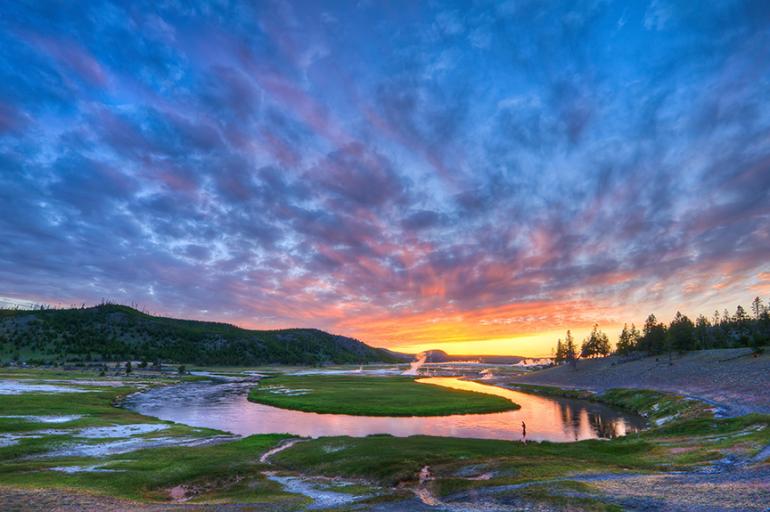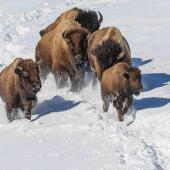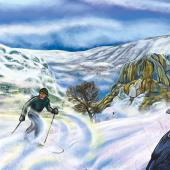Wild & Wondrous
Fishing Yellowstone Park.
There are over 100 lakes and thousands of river miles in Yellowstone Park. Nowhere else in the world is so much public water found in such a small area. Throw in dramatic scenery and abundant wildlife, and you’ve got the makings of fishing memories to last a lifetime. Several varieties of game fish are native to Yellowstone, and still more have been introduced. You can fish for cutthroat, rainbow, brown, brook, and lake trout, along with grayling and mountain whitefish.
Regulations
The Park’s general fishing season runs late May to early November. There are some exceptions, so be sure to check the National Park Service fishing regulations booklet. Anglers 16 and older must purchase a Yellowstone National Park fishing permit; kids 13-15 must obtain a special permit, free of charge. All fees stay within the fisheries program in Yellowstone.
When to Fish
Yellowstone’s average elevation is 7,000 feet, which means summer comes late in the Park. The first river to clear of snowmelt is the Firehole, and it’s often the only game in on opening day. This river offers fine dry-fly fishing during daily mayfly and caddis emergences. By the second week of June, the Gibbon and Madison rivers clear and the ice melts from Yellowstone Lake. One by one, the Park’s rivers run clear of snowmelt and most are fishable by July 4. The last rivers to clear up are typically the Lamar and Yellowstone in early July.
There is no “best time” to fish the Park. From May through the end of June, the best places to fish are the Firehole, Gibbon, Lewis, and Madison Rivers. Yellowstone and Trout lakes are unbeatable when they open June 15. In July, all Park waters become fishable. Insect hatches are at their peak, and this is a favorite time for dry-fly fishers.
August is the best time to fish lakes in the Park and a great time to head into the backcountry. All rivers except the Firehole and Madison (due to high water temperatures) continue to fish well through the month. As aquatic insects wane in late summer, terrestrials play an important role in trout diets.
Only a few hatches remain by September and October. The big fall green drakes appear on the Lamar River and Slough Creek along with tiny blue-winged olives (BWO) and midges. The Madison and Firehole become fishable again and produce excellent hatches of BWOs, caddis, and midges. October is the best month to catch the large migrating fish in the Lewis and Madison rivers. As the weather cools and spawning time approaches, these large trout become aggressive and territorial, attacking baitfish imitations and other large streamer flies.
Where to Fish
The Park can be broken into four sections: the northwest, northeast, southeast, and southwest areas.
The Madison, Gallatin, Gardner, and Gibbon rivers are four of the most popular rivers in the Park, all located in the northwest section. All are easily accessible by car and rated blue-ribbon waters. The Gardner is overlooked in favor of more publicized waters—most locals keep it under their hats. This river offers something for everyone, from meadow water to heavy-flowing canyon stretches. Attractor flies and terrestrials provide fun fishing all summer. Brook, brown, cutthroat, and rainbow trout are in good numbers on this little river, and mountain whitefish are plentiful in the lower stretches near the North Entrance.
The Gallatin holds diverse and abundant insect populations, providing plenty of trout food—plan on catching some hefty specimens. Deep pools and undercuts harbor large brown trout and elusive grayling, while riffles and pocket water hide rainbows and brook trout. Tributaries to these rivers contain abundant fish and a more low-key setting.
The Madison River can be accessed 14 miles inside the Park from West Yellowstone. This river fishes best in June and again in September and October when large numbers of migrating brown and rainbow trout move in to spawn.
The northeast section includes the Lamar and Yellowstone rivers. The Yellowstone is accessed along the 13-mile road from Canyon to Lake, with plenty of turnouts and picnic areas. The fish are mostly Yellowstone Lake cutthroat trout that have dropped downstream from the lake. Below Yellowstone Falls to Gardiner, the river cuts through two canyons with difficult access. Don’t ignore the tributaries or lakes in this section—big prizes have come out of both.
The southeast section includes the Lewis, Heart, and Snake rivers. This is the most remote area in the continental U.S., containing the largest concentration of grizzly bears in the Lower 48, so don’t forget your bear spray. The Lewis River is reached off the West Thumb / South Entrance highway. For two miles, access is good for big browns with fine hatches and terrestrial fishing. When the river enters the canyon, access becomes nearly impossible. The Heart River is best reached from the South Entrance, but requires a 12-mile hike. The Snake River is best fished off the South Entrance road. Access is more difficult once you hike a short distance from the road, but the first short section is good fishing for 12- to 16-inch cutthroat and whitefish.
Geysers, lakes, and waterfalls characterize the southwest section of Yellowstone. Bison, elk, deer, moose, and bears may be your only companions. This section features the Firehole and Bechler Rivers and their tributaries. The Bechler contains rainbow and cutthroat, while the Firehole River has been called “the strangest trout stream on earth.” Geysers, fumeroles, mud pots, and other curiosities make this river one of the most interesting to fish, and you must match the hatch on this river to be successful. Tributaries to the Bechler like Fall River, Mountain Ash Creek, and Boundary Creek can offer fine angling for those willing to make the hike.
This is only a tiny sampling of Yellowstone waters available to anglers. For more detailed information, check with fly shops in gateway communities when you purchase your Yellowstone fishing permit.
Craig Mathews is founder and owner of Blue Ribbon Flies and has authored nine books on fly-fishing Yellowstone and the West.












